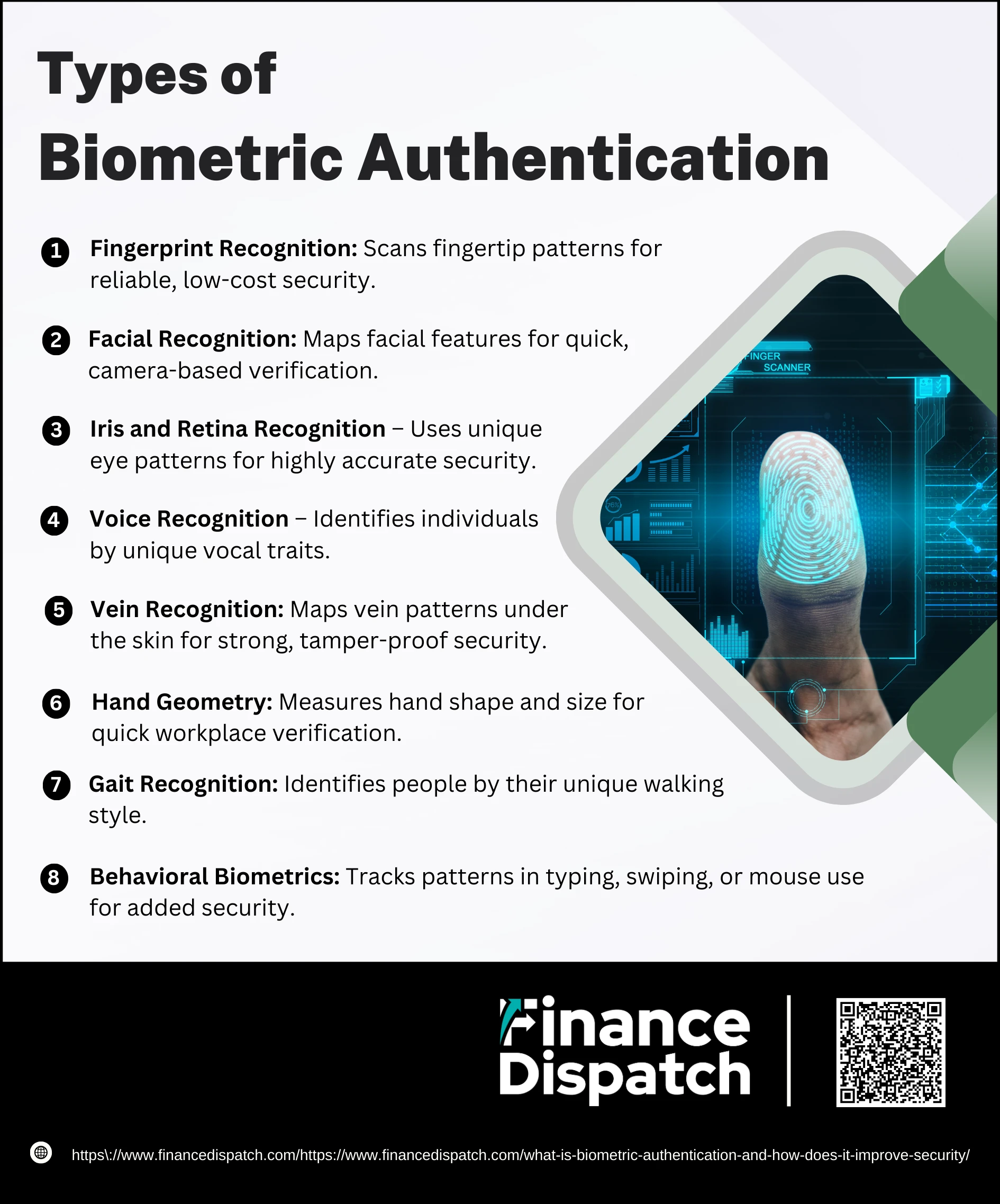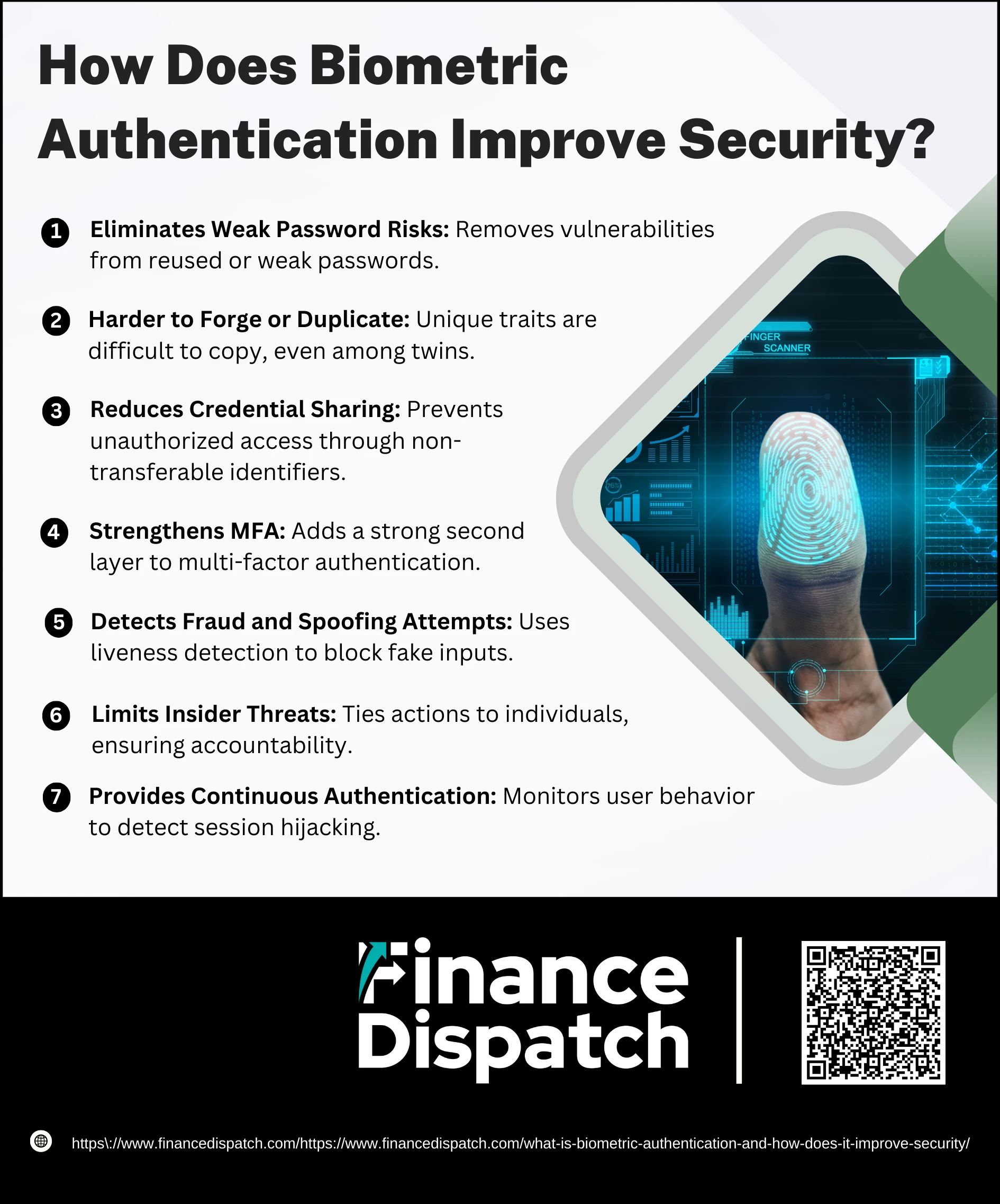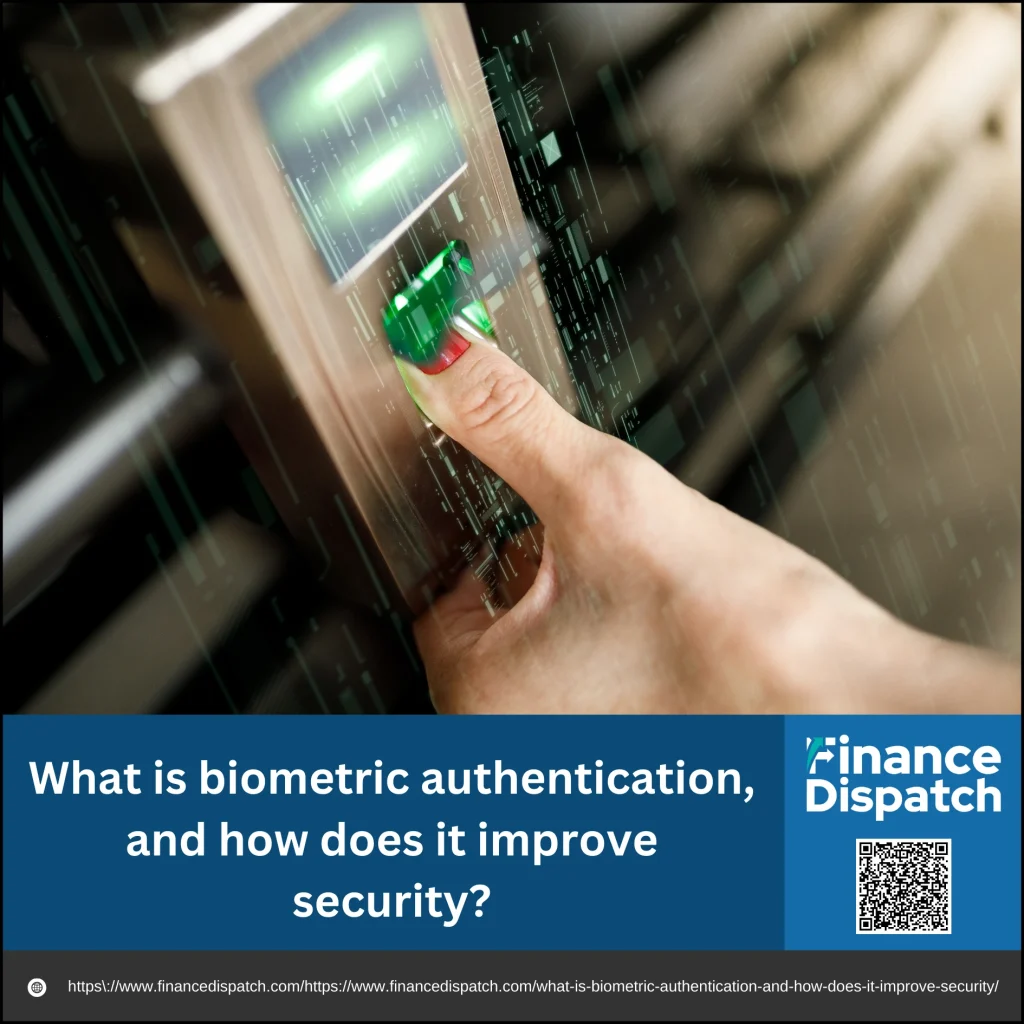In today’s digital world, where data breaches and identity theft are increasingly common, relying on passwords or PINs alone is no longer enough to keep information secure. Hackers can steal credentials, guess weak passwords, or trick users through phishing, making traditional methods of authentication highly vulnerable. Biometric authentication offers a stronger alternative by verifying identity through unique physical or behavioral traits, such as fingerprints, facial recognition, or voice patterns. Unlike passwords, these identifiers are tied to who you are, making them harder to steal or replicate. Beyond improved security, biometrics also deliver speed and convenience, allowing people to access devices, applications, and even financial transactions with just a touch or glance.
What is Biometric Authentication?
Biometric authentication is a security process that verifies a person’s identity using their unique physical or behavioral traits. Instead of depending on something you know, like a password, or something you have, like a security card, biometrics relies on something you are. This could be your fingerprint, facial features, voice, iris pattern, or even the way you type or walk. Because these traits are unique to each individual and difficult to duplicate, biometric authentication provides a stronger and more reliable way to confirm identity compared to traditional methods. It is increasingly used to secure smartphones, banking apps, workplaces, and even border control systems, offering both heightened protection and a more seamless user experience.
 How Biometric Authentication Works
How Biometric Authentication Works
Biometric authentication may sound technical, but the process is straightforward. It begins by registering a person’s unique trait, securely storing it, and then using it for future comparisons whenever that person tries to log in. Below are the key steps explained in detail:
1. Enrollment
The first step is to “teach” the system who you are. A fingerprint scanner, camera, microphone, or another sensor captures your biometric data—such as your fingerprint, facial features, or voice sample. Instead of saving the raw image or sound, the system extracts distinctive points (like ridge patterns in fingerprints or distances between facial landmarks) and converts them into a digital template.
2. Storage
Once the digital template is created, it must be stored securely for later use. This storage can be on the local device (like a smartphone), in a centralized server, or within specialized encrypted databases. To protect user privacy, most systems don’t keep the raw biometric data—only encrypted templates that can’t easily be reverse-engineered.
3. Capture
Each time you try to authenticate, the system captures a fresh biometric sample. For example, placing your finger on a scanner, looking into a camera, or speaking into a microphone generates new input data. This ensures that authentication happens in real time and confirms that it’s actually you attempting to access the system.
4. Comparison
The newly captured biometric sample is then compared with the stored template using pattern-matching algorithms. Instead of looking for a perfect match, the system checks for similarity by calculating how closely the patterns align. Because small variations (like lighting, background noise, or finger placement) can occur, the system sets a matching threshold to determine whether the new input is “close enough” to the stored data.
5. Decision
Finally, the system makes a decision. If the similarity score meets or exceeds the threshold, access is granted. If not, access is denied. Advanced systems may also use “liveness detection” to ensure the input is genuine (for example, checking for blinking eyes in facial recognition or blood flow in fingerprints), preventing spoofing attempts with photos, recordings, or fake prints.
 Types of Biometric Authentication
Types of Biometric Authentication
Biometric authentication uses traits that are unique to each person. These traits can be physical, like fingerprints or facial patterns, or behavioral, like the way you type or walk. Below are the main types of biometric authentication, explained with their uses, strengths, and challenges.
1. Fingerprint Recognition
This is the most common and affordable form of biometric authentication. It scans the ridges, whorls, and minutiae points on your fingertip. Fingerprints are unique even among identical twins, making them highly reliable. They are used in smartphones, laptops, employee attendance systems, and even in financial apps for payment approval. However, cheap scanners can sometimes be fooled with fake prints, and wet or dirty fingers may cause errors.
2. Facial Recognition
Facial recognition systems map key points on the face—such as eye distance, nose shape, and jawline—to create a digital faceprint. It is convenient because users only need to look at a camera, which is why it’s popular for unlocking phones and airport security. Advanced systems also use “liveness detection” to ensure a real face is being scanned, preventing spoofing with photos or masks. Lighting and changes in appearance (glasses, makeup, aging) can sometimes affect accuracy.
3. Iris and Retina Recognition
These methods focus on the eyes. Iris recognition scans the colored ring around the pupil, while retina recognition maps the unique blood vessel pattern at the back of the eye. They are among the most accurate methods, often used in high-security government or research facilities. However, they require specialized, often expensive equipment and may feel invasive to some users.
4. Voice Recognition
Each person’s vocal tract shape, pitch, and tone are unique, which makes voiceprints useful for authentication. Voice recognition is widely used in call centers, banking services, and smart home devices. It’s hands-free and convenient, but background noise or illness (like a cold) can disrupt accuracy. With the rise of AI-generated voice cloning, extra layers of security are needed.
5. Vein Recognition
Vein recognition maps the pattern of veins under the skin, usually in the palm or finger, using infrared light. Because vein patterns are inside the body, they are nearly impossible to copy, making this method very secure. It is already in use for banking security in some countries. The downside is that scanners are expensive and less common compared to fingerprint readers.
6. Hand Geometry
This method measures the shape and proportions of the hand, including finger length, palm size, and knuckle spacing. It is useful for workplace access control systems where quick verification is needed. While less precise than fingerprints or iris scans, it works well in environments with many users who need fast entry.
7. Gait Recognition
Everyone has a unique walking style, including stride length, body posture, and foot angle. Gait recognition can identify individuals from a distance without physical contact, making it useful in surveillance and security monitoring. However, injuries, footwear, or carrying heavy loads can alter gait, reducing accuracy.
8. Behavioral Biometrics
Unlike physical traits, behavioral biometrics study patterns in how people interact with technology. Examples include typing rhythm, touchscreen swipes, or mouse movement. These can run quietly in the background, adding an extra security layer. While less accurate on their own, they are powerful when combined with other methods in multimodal authentication systems.
 How Does Biometric Authentication Improve Security?
How Does Biometric Authentication Improve Security?
Biometric authentication strengthens security by using traits that are unique, constant, and difficult to duplicate. Unlike passwords that can be stolen or guessed, or access cards that can be lost, biometric identifiers are always with you. This makes them an effective barrier against cyberattacks, identity theft, and unauthorized access. Here are the main ways biometrics improve security in practice:
1. Eliminates Weak Password Risks
Passwords are often reused, written down, or made too simple to remember, which makes them an easy target for hackers through brute force or phishing. By replacing or supplementing passwords with biometric checks, organizations remove one of the weakest links in digital security.
2. Harder to Forge or Duplicate
Traits such as fingerprints, iris patterns, or vein structures are extremely difficult to copy. Even identical twins don’t share all biometric markers. This makes it far more challenging for attackers to break in using stolen or fake credentials.
3. Reduces Credential Sharing
An employee could share a password or swipe card with someone else, intentionally or unintentionally. Biometric identifiers cannot be transferred—they belong only to the individual. This ensures accountability and prevents unauthorized access through credential sharing.
4. Strengthens Multi-Factor Authentication (MFA)
When combined with traditional methods, such as a password or one-time code, biometrics add a powerful second layer of defense. Even if an attacker manages to steal the first factor, they would still need the person’s physical or behavioral traits, which are much harder to obtain.
5. Detects Fraud and Spoofing Attempts
Modern systems integrate “liveness detection” technology to ensure the biometric sample comes from a real, present human. For example, facial recognition may require blinking or head movement, and fingerprint scanners may detect blood flow. This makes it very difficult for attackers to use photos, recordings, or fake prints to gain access.
6. Limits Insider Threats
Not all threats come from outside—sometimes, employees or contractors misuse access rights. With biometrics, every action is tied to an individual’s unique trait, making it much harder for insiders to hide their identity or deny responsibility.
7. Provides Continuous Authentication
Beyond one-time logins, behavioral biometrics (like typing rhythm or mouse movement) can continuously verify a user in the background. This ensures that if an account is hijacked mid-session, unusual behavior will trigger alerts or logouts, adding another layer of protection.
Risks and Limitations of Biometric Authentication
While biometric authentication is widely praised for its security and convenience, it is not without challenges. Biometric systems can still be vulnerable to technical errors, privacy issues, and even hacking attempts. Understanding these risks helps organizations and individuals use the technology more responsibly and with proper safeguards.
Key risks and limitations include:
1. Privacy Concerns – Collecting and storing biometric data raises fears about surveillance and misuse by organizations or governments.
2. Irreplaceable Data – Unlike passwords, biometrics cannot be reset. If stolen, a fingerprint or iris scan puts the user at lifelong risk.
3. False Positives and False Negatives – Systems may sometimes allow unauthorized access or block valid users due to environmental factors, injuries, or changes in appearance.
4. High Implementation Costs – Advanced scanners and secure storage systems can be expensive, making it harder for smaller businesses to adopt.
5. Accessibility Issues – People with disabilities, injuries, or health conditions may find certain biometric methods difficult to use.
6. Environmental Factors – Dirt, lighting, background noise, or even wearing glasses can interfere with recognition accuracy.
7. Potential for Spoofing – While harder than hacking a password, fake fingerprints, masks, or AI-generated voices can sometimes trick poorly designed systems.
8. Dependence on Technology – Hardware or software failures could lock out legitimate users, causing inconvenience or disruption.
Real-World Use Cases of Biometric Authentication
Biometric authentication is no longer limited to high-security labs or spy movies—it has become part of everyday life. From unlocking your phone to verifying your identity at airports, biometrics are used across industries to balance security with convenience. Here are some of the most common and impactful real-world applications:
Examples of use cases include:
1. Banking and Payments – Fingerprints or facial scans confirm mobile banking logins and authorize digital payments, reducing fraud.
2. Healthcare – Hospitals use biometrics to verify patient identity, secure medical records, and prevent medication errors.
3. Travel and Border Control – E-passports and airport facial recognition streamline check-ins and immigration processes while ensuring security.
4. Law Enforcement – Police agencies rely on fingerprints, facial recognition, and DNA to identify suspects or missing persons quickly.
5. Smartphones and Consumer Devices – Most modern devices use fingerprint or face unlock for secure and effortless access.
6. Workplace Access Control – Companies implement fingerprint or iris scanners to restrict entry into sensitive areas and track attendance.
7. Retail and E-commerce – Some stores use palm or face recognition for cashier-less payments, creating faster checkout experiences.
8. Education – Schools and universities apply biometrics for student ID, attendance tracking, and secure exam verification.
9. Government Services – National ID programs and voting systems in some countries use biometrics to confirm citizen identity.
Future of Biometric Authentication
The future of biometric authentication is moving toward smarter, more secure, and more seamless experiences. Advancements in artificial intelligence and machine learning are making recognition systems faster and more accurate, while also improving their ability to detect spoofing attempts like deepfakes or fake fingerprints. Contactless biometrics, such as facial and iris recognition, are gaining popularity for hygiene and convenience, especially in airports, hospitals, and workplaces. At the same time, behavioral biometrics—like the way a person types, walks, or swipes—are being integrated for continuous background authentication, reducing reliance on one-time checks. To address privacy concerns, more systems are shifting toward decentralized or on-device storage, so sensitive biometric data never leaves the user’s control. As regulations tighten and technology matures, biometrics are expected to become a cornerstone of passwordless security, blending high protection with everyday ease of use.
Conclusion
Biometric authentication is transforming the way identities are verified by replacing vulnerable passwords with traits that are unique to every individual. From fingerprints and facial recognition to behavioral patterns like typing or walking, these methods provide stronger security while also offering speed and convenience. However, as secure as biometrics may be, they also come with risks such as privacy concerns, data breaches, and accessibility challenges, which must be addressed through careful implementation and strong safeguards. Looking ahead, as technology advances and regulations strengthen, biometric authentication is set to play a central role in building a passwordless future—one that combines enhanced protection with a smoother user experience.



